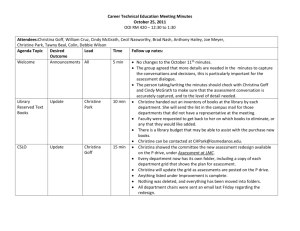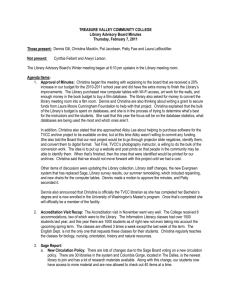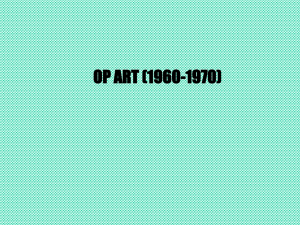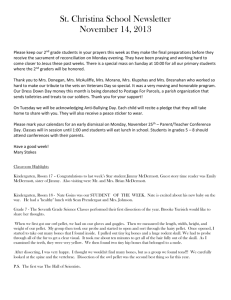REMEMBERING CHRISTINA GROF: SPIRITUAL SEEKER
advertisement
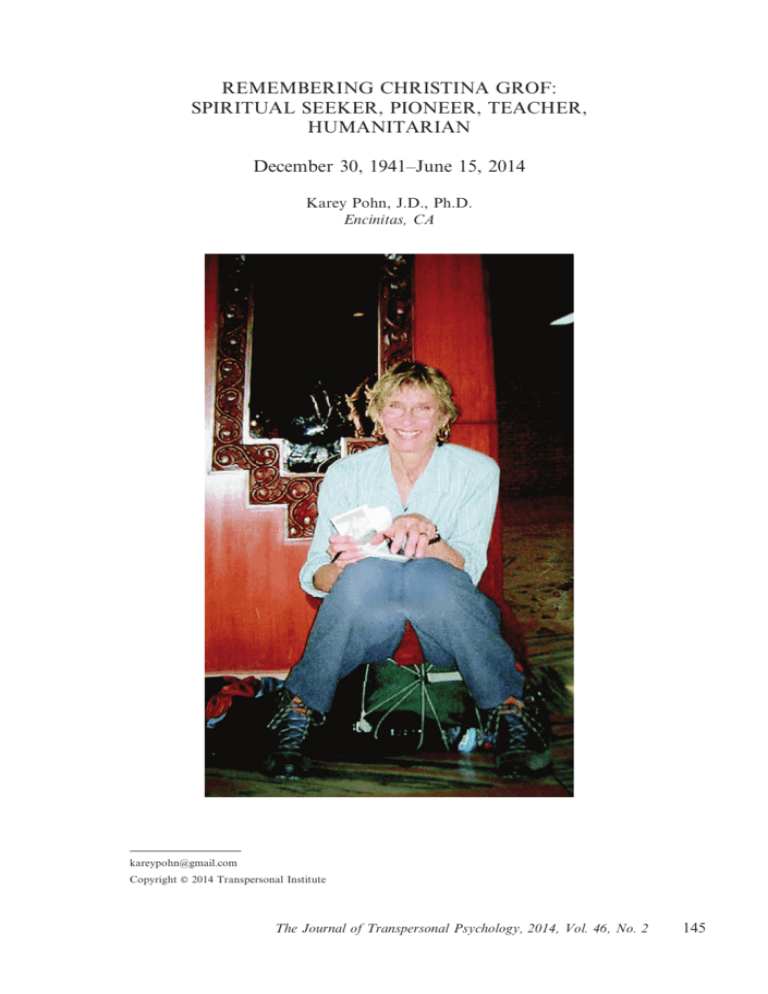
REMEMBERING CHRISTINA GROF: SPIRITUAL SEEKER, PIONEER, TEACHER, HUMANITARIAN December 30, 1941–June 15, 2014 Karey Pohn, J.D., Ph.D. Encinitas, CA kareypohn@gmail.com Copyright ’ 2014 Transpersonal Institute The Journal of Transpersonal Psychology, 2014, Vol. 46, No. 2 145 Christina Grof died quietly and unexpectedly June 15th, 2014 at her home in Mill Valley, CA, and the transpersonal community lost a splendid and sensitive soul. When I look back on the life of this intrepid experiential transpersonal pioneer, I am reminded of the poet Rainer Maria Rilke’s quote from Letters to a Young Poet: Be patient toward all that is unsolved in your heart and to try to love the questions themselves like locked rooms and like books that are written in a very foreign tongue. Do not now seek the answers, which cannot be given you because you would not be able to live them. And the point is, to live everything. Live the questions now. Perhaps you will then gradually, without noticing it, live along some distant day into the answer. (1993, p. 35) Christina Grof did indeed bravely and fully live and love the questions, and more importantly she shared her profound life and struggles generously and publically with the world, in the hope of helping others. Christina grew up in Hawaii, although she was born in Roanoke, Virginia. When Christina was 4 years old, her biological father left; Christina’s mother remarried, and a couple of years later the family moved to Hawaii. But there was trouble in paradise—a dysfunctional family dynamic ensued, and Christina experienced physical and sexual abuse growing up at the hands of her stepfather. For as long as she could remember, Christina had a longing for something larger than herself, and she found solace in nature and in the Episcopal Church. The church was a safe place for Christina; it had beautiful music, stained glass, and there was a wonderful Maori minister, Manu Bennett, from New Zealand. However, as Christina grew older, the dogma of the church held little appeal, and instead she focused on literature, mythology and art. Christina attended Sarah Lawrence College and had the good fortune to have noted mythology teacher Joseph Campbell during her senior year. She became friends with Joseph and his wife Jean Erdman (another Hawaii native), and Campbell would later be instrumental in Christina’s life trajectory. Christina was an extremely creative person and gifted artist and painter, who was also able to teach others. After college, Christina returned to Hawaii, married a teacher and became an art teacher at a progressive elementary school. Christina got involved with yoga as a form of exercise and became interested in the Lamaze method of natural childbirth. During the delivery of both her son Than in 1968 and her daughter Sarah in 1970, she experienced intense physical symptoms—breathing and shaking uncontrollably, along with white light shooting up her spine and exploding in her head. Having no context for the experience, she thought she was crazy. This was the beginning of what would later be coined by Christina and Stan as a spiritual emergency. But Christina had no roadmap for her experience, and the doctors administered morphine and thorazine to calm down her symptoms. 146 The Journal of Transpersonal Psychology, 2014, Vol. 46, No. 2 Christina’s interest in spirituality continued and she went to see Swami Muktananda of the Siddha Yoga tradition, which was then very new and not yet popular in the West. While attending a weekend course in July 1974, at which she received shaktipat, Christina’s spontaneous spiritual emergence was reignited and she began experiencing visions along with the strange breathing and spontaneous movements. A car accident in May of 1975, which included a near death experience, exacerbated these kundalini type experiences further. Christina sought to keep her symptoms under control, but was experiencing many difficulties, and her marriage collapsed under the strain. In the summer of 1975, Christina then went to the mainland to sort things out in her life, and, on a subsequent trip to New York, she told her friend and teacher Joseph Campbell about her experiences over dinner, recognizing elements of death, birth, rebirth and spirituality. Campbell then promptly told her about his friend Stan Grof at Esalen and made the introduction. Two weeks later, Christina went to meet Stan at Esalen and attended a sixweek workshop, where they fell in love. Later, in the fall of 1975, Christina and Stan began their life together, and went on to marry and live at Esalen where they both taught and hosted thirty month-long workshops. This newfound love came at a cost—Christina lost legal custody of the children in a lawsuit, as their father was an influential member of the community and was declared a better provider. This was very painful for Christina, and, although Christina’s life experience and life work took her in a different direction, she made the most of what time she was able to spend with the children. In the late 1970s—at a month-long workshop about ‘‘Spiritual Experience or Psychosis,’’ Christina actually began to have another particularly intense episode of spiritual emergency, and in integrating the experience Spiritual Emergency was born. In 1980, Christina founded the Spiritual Emergence Network (SEN) and later co-wrote Spiritual Emergency: When Personal Transformation Becomes a Crisis (1989) and The Stormy Search for the Self: A Guide to Personal Growth Through Transformational Crises (1990). Thus began a lifelong pattern of Christina working on herself, like an alchemist, using the prima materia or lead of her own experience and transforming it through suffering and intense pressure into the philosopher’s stone or gold. Christina’s next challenge was addiction. Her attempt to control her kriyas (spontaneous movements) in situations where she could not work with them, as for example during airline travel, along with a genetic predisposition to alcoholism, led her to turn to alcohol. Her struggle with alcohol and her successful recovery was the subject of her next book in 1993, The Thirst for Wholeness: Attachment, Addiction and the Spiritual Path. Christina and Stan co-founded the International Transpersonal Association (ITA) and organized many international conferences. Along the way they would meet and host luminaries and friends from Mother Theresa, Ram Dass, His Holiness the Dalai Lama, to Jack Kornfield and John Cleese. These conferences were held all over the world from India, Australia and Europe, and Remembering Christina Grof 147 both of the Americas. These legendary meetings planted seeds that grew worldwide into national transpersonal organizations, most of which continue to this day. Together, during the 38 years of their marriage and collaborative partnership, the Grofs traveled, taught, held conferences, did lectures workshops, and conducted trainings on every continent except for Antarctica. Because Christina had her feet in both the Transpersonal and Addictions fields, she noticed that the Twelve Step programs had an effective strategy to deal with alcohol and addictions, but there was not a conceptual framework that was really acceptable to academicians and clinicians. In the Transpersonal Psychology field, paradoxically, the situation was the opposite; there was a conceptual framework for spirituality, but no effective strategy to help alcoholics and addicts. Addiction to spirituality (spiritual bypass) was another problem that was often seen in the Transpersonal world. Christina believed that the two different fields should be bridged and the result was the creation of both an Esalen workshop and two ITA conferences entitled ‘‘Mystical Quest, Attachment and Addiction,’’ that were based on her inspiration. This was another pattern that is present in Christina’s life. Christina was a master at helping people in creative ways, always seeking to bring the best to the table, so to speak. An example was a tradition she created for her own children and their friends—the ‘‘Messy Meal.’’ As a reward for having good table manners at other times, a special meal happened where kids were able to be as wild and creative with their food and food choices as they wanted. These occasions are the source of cherished memories for all who had the privilege of attending! In the same vein, another tradition that Christina instituted and organized was Children’s Day at Esalen each year—a special day each summer was set aside just for the children where games and elaborate treasure hunts were organized, with face painting, music, and special performances all just for the children, although those who were kids at heart were not excluded! Christina and Stan also jointly created Holotropic Breathwork together at Esalen. Both Stan and Christina have the gift of recognizing and using elements from other traditions and combining them to help people to transform. Both had experienced and seen the power of breathing in transformative work—in psychedelic sessions, Christina’s own yoga and labor experiences, and the use of breath in many other traditions and transformative practices. Stan had used music and mandala drawing in the psychedelic sessions. Christina brought her background as an artist and her musical ear, which she inherited from her father who had been a musician, becoming the music woman. Together they incorporated music and mandala drawing, along with the important concepts of set and setting and the breather/sitter relationship, as key parts of Holotropic Breathwork. Then they created a training program and began to train facilitators. (In 2010, they co-authored Holotropic Breathwork: A New Approach to Self Exploration and Therapy.) Having suffered for many years from chronic back pain and lupus, a complex and painful autoimmune disease that interfered with her ability to travel and keep up the hectic pace, Christina then began the practice of letting go 148 The Journal of Transpersonal Psychology, 2014, Vol. 46, No. 2 professionally. She also had to withdraw from the intense demands of workshops and trainings as well, eventually turning over her beloved music woman role to those whom she had skillfully trained. Although this was a painful process, she focused on finding spirituality in the everyday world and continued her lifelong pursuit of painting and healing. Christina’s strength was in her lived experience and her dedication to valiantly living the questions. At times, Christina also suffered being in the shadow of Stan’s immense intellect and prolific legacy, and so she has remained a bit of an unsung heroine. Stan himself credited Christina with shining a spotlight on areas he would otherwise never have seen or considered, and for also being at the forefront of these areas and at the memorial service for Christina on October 14th 2014 at Spirit Rock, in Woodacre, California, Stan explained: Our cooperation was so close that it was not always easy to separate one person’s contributions from the other’s. Unfortunately, because we live in a patriarchal society, Christina often did not receive any credit for projects that she had created single-handedly—such as founding the Spiritual Emergency Network (SEN) or bridging the addictions field and transpersonal psychology—as well as those to which she made substantial contributions—such as Holotropic Breathwork, Esalen month-longs, and international transpersonal conferences. This was further complicated by the fact that, in later years, low energy due to her chronic autoimmune disease did not allow her full participation in many of the events. Christina received three honorary doctorates during her lifetime and was very happy and excited about the plans for the Stanislav and Christina Grof Foundation and gave her blessing to it. The Foundation is dedicated to preserving, protecting, extending, and showcasing the work of both of these brilliant humanitarians and pioneers, although regrettably Christina did not live to see its formal birth during the October 26th launch and Open Space. As a tribute to Christina, the event was held at The Women’s Building in San Francisco, and during the day people representing all areas of the Grof legacy were in attendance. In mid May of this year, Stan asked me to read the galleys and review Christina’s latest book The Eggshell Landing: Love, Death and Forgiveness in Hawaii for the Inner Door, a small publication of AHBI (Association for Holotropic Breathwork International). I read the deeply moving book in two sittings and sent the book review to Stan at the end of first week of June. Stan told me that that Christina wasn’t feeling well, but loved the review and would get back to me when she was feeling better. I was so struck by the beauty and courage of her words that I was really excited to talk with her about it. Unfortunately, I never got that chance, as she died a few days later, less than a week after boxes containing the book arrived at her home. Christina’s book, The Eggshell Landing, bravely and boldly recounts her astonishing story of forgiveness of her stepfather, who had abused her as a child, when she decided to support him in his dying process. ‘‘Eggshell landing’’ is a nautical term that refers to bringing a vessel elegantly and skillfully ashore, so Remembering Christina Grof 149 that it comes within an eggshell’s width of the dock. Christina uses this term as a metaphor for her experience of reconciling with her stepfather. The book begins shockingly and powerfully with a frankness that is quite refreshing, as Christina owns up to a full spectrum of private thoughts that show her humanity. In this courageous act, Christina allows us to not only be with her, but to have and be with our own feelings without judgment. Christina takes us seamlessly back and forth from present day to her childhood and back again, like a skilled weaver, shuttling the weft threads across the warp of her life, creating a rich tapestry of great beauty and emotion. An accomplished painter, with an exquisite eye for color, Christina uses her deep creativity and aesthetic sense to paint breathtakingly visual descriptions along the way. We are there with her on every step of this amazing journey. The Eggshell Landing is a coda to, and provides a context for, The Thirst for Wholeness and The Stormy Search for the Self. Like in these two other works, and as in Christina’s life in general, she is very transparent, honest, and candid about her experience. In this narration of her own holotropic journey of forgiveness, Christina has given us another viscerally compelling lived experience that perhaps, if we are lucky, can lead us to our own eggshell landings of forgiveness. She shows us the tremendous healing that is possible when we have the courage to begin this journey for ourselves. On the occasion of Christina’s 50th birthday celebration in December of 1991, Roger Walsh succinctly described the nature of Christina’s life’s work to attendees: ‘‘I do not know anybody else who–-like Christina–-has been able to transform his or her personal problems into projects serving humanity.’’ Despite her physical and emotional challenges, Christina brought a warm related spirituality to everything she did and was inclusive and welcoming. Her creativity infused all aspects of her life and she brought art and beauty into everyday life, especially at the holiday times—and she encouraged others to do the same. Christina’s memorial service in October was filled with touching and amusing stories that revealed her deep caring and at times comical nature. Last June, with the delivery of this important story Christina finally and quietly made her own Eggshell Landing, having completed a work of great compassion, strength, beauty and power that will no doubt help others on their journeys. Christina is survived by her beloved husband Stanislav, son Than and daughter Sarah, as well as five grandchildren, many close friends and family, along with hundreds of thousands of people whose lives have been and will continue to be touched by her many contributions to humanity. Below is the epilogue, the closing words from the book, which is her last and perhaps best work: 150 The Journal of Transpersonal Psychology, 2014, Vol. 46, No. 2 There will be more to do, more life to live; More valleys through which to pass, more mountains of joy, more hope, more work, more struggles, more strength. But there is a difference now. Once, gaping wounds within that tormented daylight and dreams. Now those wounds are closed. Where they existed, fading scars whisper of the wilderness, of the power to endure, of love, of Grace. Fading soul scars are banners of a victimless victory. I will not forget, but never again will I be bound by the deeds that caused them. Never. Never again. (C. Grof, 2014, pp. 371–372) REFERENCES GROF, C. (2014). The eggshell landing: Love, death and forgiveness in Hawaii. Retrieved from https://www.smashwords.com/books/view/443617. RILKE, R. M. (1993). Letters to a young poet (Rev. ed.). (M.D. Herter, Trans.). New York, NY: W. W. Norton. (Original work published 1934) BIBLIOGRAPHY GROF, C. (1993). The thirst for wholeness: Attachment, addiction and the spiritual path. New York, NY: HarperCollins. GROF, C. & GROF, S. (Eds.). (1989). Spiritual emergency: When personal transformation becomes a crisis. Los Angeles, CA: Tarcher/ Putnam. GROF, C., & GROF, S. (1990). The stormy search for the self: A guide to personal growth through transformational crises. Los Angeles, CA: Tarcher/ Putnam. GROF, C., & GROF, S. (2010). Holotropic breathwork: A new approach to self exploration and therapy. Albany, NY: SUNY Press. The Author Karey Pohn, JD, Ph.D., is a depth psychologist who specializes in the archetypal nature of cultural creations. Stanislav Grof, M.D., was her dissertation chair, and her doctoral work on the archetypal aspects of play follows on from the Cosmic Game, authored by Stanislav Grof. Karey is an adjunct faculty member at the Pacifica Graduate Institute and Antioch University in Los Angeles, California, has served on the board of The Association for Holotropic Breathwork for the past 7 years, and is the Secretary and Treasurer of the Stanislav and Christina Grof Foundation. She is also an executive coach and consultant who helps people to play more, think better, and realize their dreams. Remembering Christina Grof 151
